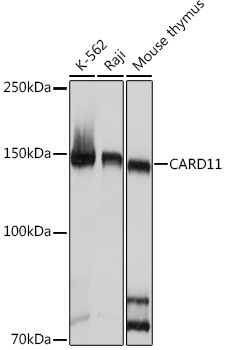Anti-CARD11 Antibody (CAB9652)
- SKU:
- CAB9652
- Product type:
- Antibody
- Reactivity:
- Human
- Mouse
- Rat
- Host Species:
- Rabbit
- Isotype:
- IgG
- Antibody Type:
- Monoclonal Antibody
- Research Area:
- Cell Biology
Description
| Antibody Name: | Anti-CARD11 Antibody |
| Antibody SKU: | CAB9652 |
| Antibody Size: | 20uL, 50uL, 100uL |
| Application: | WB IHC IF |
| Reactivity: | Human, Mouse, Rat |
| Host Species: | Rabbit |
| Immunogen: | A synthesized peptide derived from human CARD11 |
| Application: | WB IHC IF |
| Recommended Dilution: | WB 1:500 - 1:2000 IHC 1:50 - 1:200 IF 1:50 - 1:200 |
| Reactivity: | Human, Mouse, Rat |
| Positive Samples: | K-562, Raji, Mouse thymus |
| Immunogen: | A synthesized peptide derived from human CARD11 |
| Purification Method: | Affinity purification |
| Storage Buffer: | Store at -20°C. Avoid freeze / thaw cycles. Buffer: PBS with 0.02% sodium azide, 0.05% BSA, 50% glycerol, pH7.3. |
| Isotype: | IgG |
| Sequence: | Email for sequence |
| Gene ID: | 84433 |
| Uniprot: | Q9BXL7 |
| Cellular Location: | |
| Calculated MW: | 133kDa |
| Observed MW: | 150KDa |
| Synonyms: | BENTA, BIMP3, CARMA1, IMD11, PPBL |
| Background: | The protein encoded by this gene belongs to the membrane-associated guanylate kinase (MAGUK) family, a class of proteins that functions as molecular scaffolds for the assembly of multiprotein complexes at specialized regions of the plasma membrane. This protein is also a member of the CARD protein family, which is defined by carrying a characteristic caspase-associated recruitment domain (CARD). This protein has a domain structure similar to that of CARD14 protein. The CARD domains of both proteins have been shown to specifically interact with BCL10, a protein known to function as a positive regulator of cell apoptosis and NF-kappaB activation. When expressed in cells, this protein activated NF-kappaB and induced the phosphorylation of BCL10. [provided by RefSeq, Jul 2008] |
| UniProt Protein Function: | CARD11: a CARD (caspase recruitment domain) protein that belongs to the membrane-associated guanylate kinase (MAGUK) family. MAGUK proteins function as molecular scaffolds for the assembly of multiprotein complexes at specialized regions of the plasma membrane. Contains an N-terminal CARD domain, a central coiled-coil domain, and a C-terminal region containing a PDZ, an SH3, and a GUK. Its CARD domain associates with the CARD domain of BCL10. BCL10 activates NF-kappaB through the IkappaB kinase complex in response to upstream stimuli. Apparently activates NF-kappaB and induce the phosphorylation of BCL10. Detected in adult peripheral blood leukocytes, thymus, spleen and liver. Also found in promyelocytic leukemia HL-60 cells, chronic myelogenous leukemia K562 cells, Burkitt's lymphoma Raji cells and colorectal adenocarcinoma SW480 cells. |
| UniProt Protein Details: | Protein type:Adaptor/scaffold Chromosomal Location of Human Ortholog: 7p22 Cellular Component: T cell receptor complex; cytoplasm; plasma membrane; immunological synapse; cytosol; lipid raft Molecular Function:guanylate kinase activity; protein binding; CARD domain binding Biological Process: positive regulation of cytokine production; thymic T cell selection; positive regulation of I-kappaB kinase/NF-kappaB cascade; positive regulation of interleukin-2 biosynthetic process; T cell receptor signaling pathway; activation of NF-kappaB transcription factor; regulation of apoptosis; regulation of B cell differentiation; T cell costimulation; positive regulation of B cell proliferation; innate immune response; regulation of T cell differentiation; positive regulation of T cell proliferation; nucleotide phosphorylation Disease: Persistent Polyclonal B-cell Lymphocytosis; Immunodeficiency 11; B-cell Expansion With Nfkb And T-cell Anergy |
| NCBI Summary: | The protein encoded by this gene belongs to the membrane-associated guanylate kinase (MAGUK) family, a class of proteins that functions as molecular scaffolds for the assembly of multiprotein complexes at specialized regions of the plasma membrane. This protein is also a member of the CARD protein family, which is defined by carrying a characteristic caspase-associated recruitment domain (CARD). This protein has a domain structure similar to that of CARD14 protein. The CARD domains of both proteins have been shown to specifically interact with BCL10, a protein known to function as a positive regulator of cell apoptosis and NF-kappaB activation. When expressed in cells, this protein activated NF-kappaB and induced the phosphorylation of BCL10. [provided by RefSeq, Jul 2008] |
| UniProt Code: | Q9BXL7 |
| NCBI GenInfo Identifier: | 172046231 |
| NCBI Gene ID: | 84433 |
| NCBI Accession: | Q9BXL7.3 |
| UniProt Secondary Accession: | Q9BXL7,Q2NKN7, Q548H3, A4D1Z7, |
| UniProt Related Accession: | Q9BXL7 |
| Molecular Weight: | 133,284 Da |
| NCBI Full Name: | Caspase recruitment domain-containing protein 11 |
| NCBI Synonym Full Names: | caspase recruitment domain family, member 11 |
| NCBI Official Symbol: | CARD11 |
| NCBI Official Synonym Symbols: | PPBL; BENTA; BIMP3; IMD11; CARMA1 |
| NCBI Protein Information: | caspase recruitment domain-containing protein 11; carma 1; CARD-containing MAGUK protein 1; bcl10-interacting maguk protein 3 |
| UniProt Protein Name: | Caspase recruitment domain-containing protein 11 |
| UniProt Synonym Protein Names: | CARD-containing MAGUK protein 1; Carma 1 |
| Protein Family: | Caspase recruitment domain-containing protein |
| UniProt Gene Name: | CARD11 |
| UniProt Entry Name: | CAR11_HUMAN |






